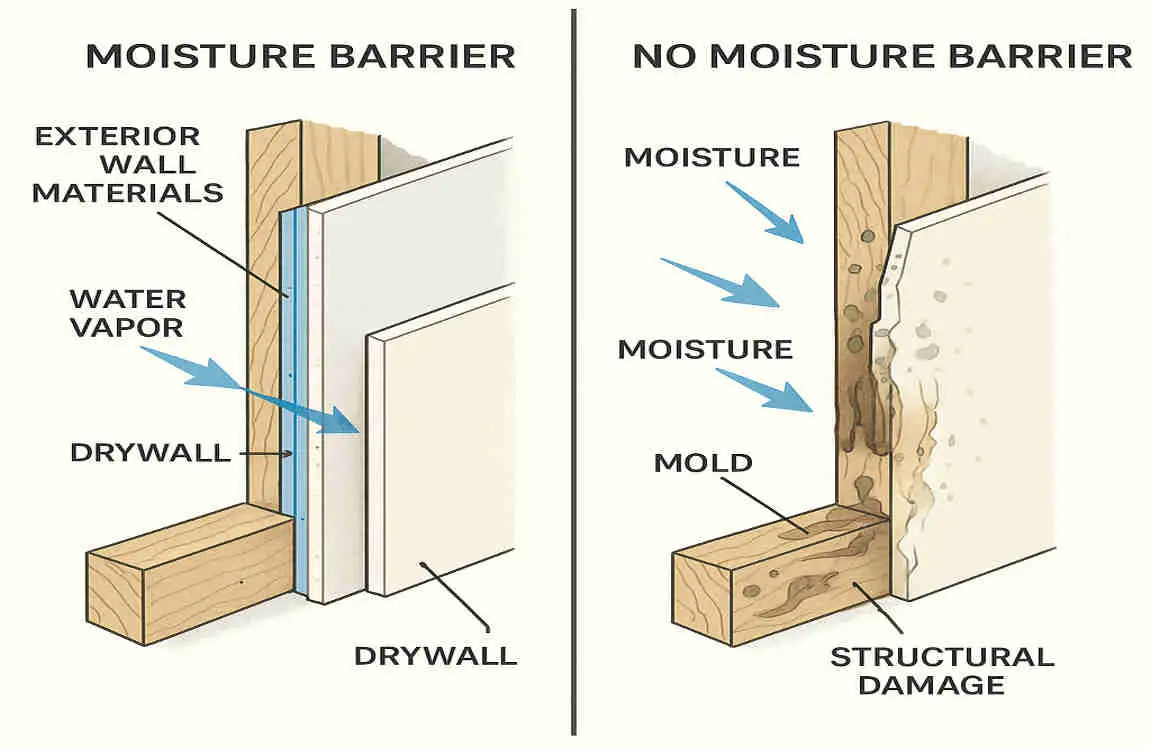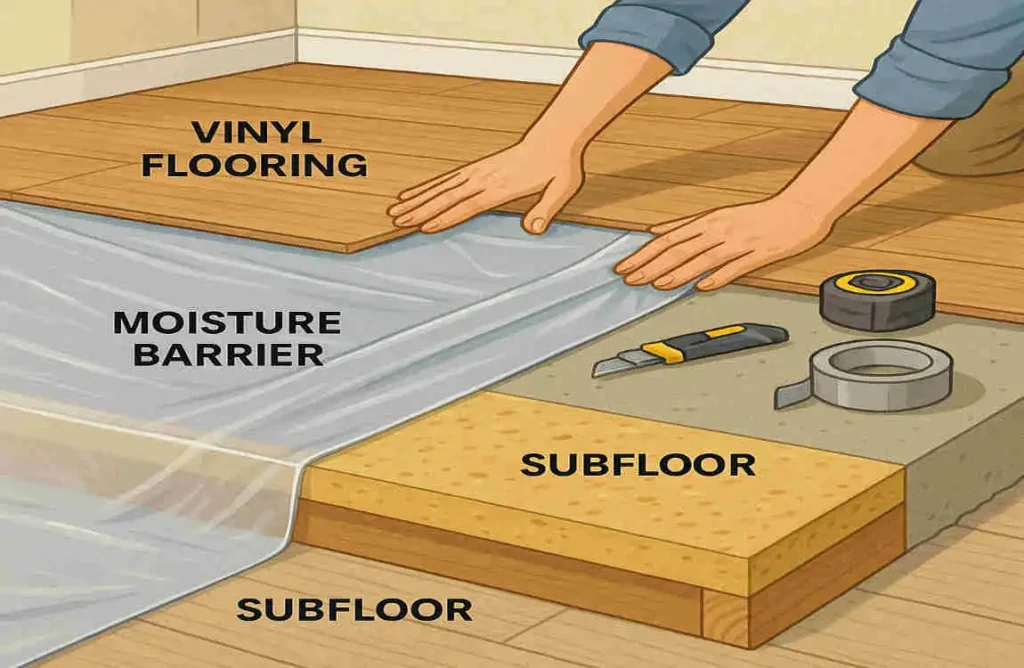Hey there, homeowner! If you’re considering sprucing up your space with fresh vinyl flooring, you’re in good company. Vinyl flooring has become a go-to choice for many folks because it’s affordable, durable, and comes in endless styles that mimic everything from hardwood to stone. But here’s the thing: installing it right means paying attention to what’s underneath. That’s where a moisture barrier comes in.
Imagine preventing mold, warping, or those annoying creaks that come from hidden dampness. Whether you’re tackling a floor kitchen remodel or updating your basement, getting this right ensures your floors last longer and look better.
What Is a Moisture Barrier and Why Is It Important?

Let’s start with the basics. A moisture barrier is a protective layer that sits between your subfloor and your vinyl flooring. Think of it as a shield that blocks water vapor from sneaking up and causing trouble. Without it, moisture from the ground or concrete can seep through, resulting in various issues.
What exactly does this barrier do? It acts like a waterproof membrane, stopping humidity and dampness from reaching your vinyl planks or sheets. This is especially key in homes with concrete subfloors, where ground moisture is a constant threat. By installing one, you’re not just protecting your floors – you’re safeguarding the entire health of your home.
Now, not all moisture barriers are the same. There are a few types that work well under vinyl flooring. The most common is polyethylene film, which is a thick plastic sheet that’s easy to roll out. It’s affordable and effective for most DIY projects. Then there are paint-on membranes, similar to liquid sealants, that you apply by brush to the subfloor. These are great for uneven surfaces because they fill in cracks as they dry.
Another option is foam underlayment with a built-in vapor barrier. This combination of cushioning and moisture protection makes it ideal for those who prefer a softer feel underfoot. Some folks go for rubberized obstacles, which are more heavy-duty and often used in basements. Whichever you choose, make sure it’s rated for vinyl – check the packaging or ask at your local hardware store.
But why bother with all this? Skipping a moisture barrier can lead to disaster. Picture this: moisture builds up, causing your vinyl to bubble, warp, or even peel away. Worse, it can foster mold growth, which isn’t just unsightly – it’s a health hazard, especially if you have allergies or kids in the house.
Over time, unchecked moisture erodes the adhesive or the flooring material itself, leading to costly repairs. I’ve seen homeowners tear out entire floors because they ignored this step. Don’t let that be you! A proper barrier extends your vinyl’s lifespan by years, keeping it looking fresh and functional.
In humid climates or areas prone to flooding, this isn’t optional – it’s essential. Even in drier spots, it’s a wise precaution. Consider your basement or bathroom; these areas naturally have more moisture, so a barrier acts as your first line of defense.
Tools and Materials Needed for Installation
Before you roll up your sleeves, let’s talk gear. Having the right tools and materials makes installing a moisture barrier under vinyl flooring a breeze. You don’t need fancy equipment – most of this stuff is available at your local home improvement store.
Start with the essentials. You’ll need a utility knife for cutting the barrier material precisely. A measuring tape is crucial to get those dimensions spot on – accuracy prevents waste and gaps. Grab a roller to smooth out the barrier and ensure it adheres well without bubbles.
Don’t forget to use double-sided tape or a stapler for securing the edges. If your subfloor is concrete, a paint roller may help apply primers or liquid barriers. For safety, always wear gloves to protect your hands from sharp edges and a mask if you’re dealing with dust or adhesives.
On the materials side, the star of the show is the moisture barrier itself. Opt for 6-mil polyethylene film – it’s thick enough to block vapor but flexible for easy handling. If you’re using a paint-on type, get a quality waterproof primer or membrane.
You’ll also want vinyl flooring underlayment if it’s not built into your barrier. Waterproof tape is key for sealing seams – make sure it’s rated for moisture. And if your subfloor needs repairs, stock up on filler or leveling compound.
Here’s a quick list of must-haves:
- Tools: Utility knife, measuring tape, roller, stapler, scissors, moisture meter.
- Materials: Polyethylene film at least 6-mil), waterproof tape, double-sided adhesive, primer for concrete.
- Safety Gear: Gloves, knee pads, dust mask, safety glasses.
When buying, prioritize quality. Cheap materials might tear easily or fail to block moisture, defeating the purpose. Read reviews and choose brands that are known for their durability. If you’re on a budget, compare prices online, but don’t skimp on thickness – thicker barriers offer better protection.
Preparations Before Installing the Moisture Barrier
Preparation is where the magic happens. Rushing into installation without prepping can lead to uneven floors or moisture leaks. So, let’s break it down step by step.
First, focus on the subfloor. Clean it thoroughly – sweep away dust, debris, and any old adhesive. Use a mild detergent and water, then let it dry completely. A damp subfloor is your enemy here.
Next, inspect for damage. Repair cracks, holes, or uneven spots with a patching compound. For wooden subfloors, sand down high points and fill lows. On concrete, use a self-leveling compound to create a flat surface. This ensures your moisture barrier lies smoothly.
Measurements matter a lot. Measure your room’s length and width, adding a few inches for overlaps and edges. Calculate the square footage to know how much barrier material you need. Cut pieces in advance, but remember to leave room for trimming later.
Acclimatizing is a game-changer. Let your vinyl flooring and moisture barrier sit in the room for 48 hours. This allows them to adjust to the temperature and humidity, preventing issues with expansion or contraction after installation.
Don’t skip checking for moisture. Use a moisture meter to test the subfloor. If readings are high above 12% for wood or 3-5 pounds for concrete, address the source – consider improving ventilation or fixing leaks.
For basements, consider adding a dehumidifier during the preparation stage. In bathrooms, ensure plumbing is leak-free. These steps make installing a moisture barrier under vinyl flooring foolproof.
Think about the room’s layout. Plan how you’ll lay the barrier, starting from one corner and working outward. Remove baseboards if needed for a clean edge.
Step-by-Step Guide: How to Install a Moisture Barrier Under Vinyl Flooring

Ready to get hands-on? This is the heart of how to install a moisture barrier under vinyl flooring. We’ll go through each step in detail, with tips to handle bumps along the way. Follow along, and you’ll have a solid foundation in no time.
Gather All Materials and Tools
Kick things off by organizing everything. Lay out your tools on a clean workbench – including a utility knife, tape, and roller. Double-check your materials list. Missing something? Now’s the time to grab it. This step sets a smooth pace and reduces frustration.
Pro tip: Work in a well-lit area. Good lighting helps spot imperfections early.
Clean and Dry the Subfloor Thoroughly
We’ve touched on this, but let’s dive deeper. Vacuum the subfloor to remove loose particles. Then, mop with a gentle cleaner – avoid soaking it. Let it air dry for at least 24 hours. Fans or a dehumidifier speed this up.
Challenge: Stubborn stains? Use a scraper gently. If it’s concrete, etch it lightly for better adhesion if using a liquid barrier.
Measure and Cut the Moisture Barrier
Accuracy is key here. Measure the room and cut your polyethylene sheets to size, allowing 6-8 inches extra on all sides. Use a straight edge for house clean floor cuts with your utility knife.
Tip: For odd-shaped rooms, cut in sections. This makes handling easier and minimizes waste.
Lay the Moisture Barrier Over the Subfloor
Start at one end of the room. Roll out the barrier smoothly, avoiding wrinkles. Overlap seams by 6 to 8 inches – this creates a continuous shield against moisture.
Secure the edges with double-sided tape or staples at every 12-inch interval. For concrete, tape works best; for wood, staples hold firm.
Common issue: Air bubbles? Use a roller to press them out as you go. Work slowly to keep it flat.
Seal the Seams Properly Using Waterproof Tape
Once laid, tape those overlaps with waterproof seam tape. Press firmly to ensure no gaps. This step is crucial – it’s what makes the barrier truly effective.
Tip: If using a paint-on barrier, apply it evenly with a brush or roller, allowing it to cure according to the instructions. Overlap painted areas for full coverage.
Trim Excess Moisture Barrier at Walls
With the barrier down, trim excess material along the walls. Leave about 2 inches of space up the wall for now – you’ll tuck this under the baseboards later.
Challenge: Uneven walls? Use scissors for precise cuts. Don’t cut too close, or you risk tears.
Inspect the Installation for Gaps or Tears
Walk the room and check every inch. Look for gaps, tears, or loose spots. Patch any issues with extra tape or material.
Pro tip: Shine a flashlight at an angle to spot subtle flaws. Fix them now – it’s harder once the vinyl is on.
Install the Vinyl Flooring According to Manufacturer’s Instructions
Finally, lay your vinyl over the barrier. Follow the maker’s guide – some snap together, others need adhesive. Ensure the barrier doesn’t shift during this.
Tip: If using underlayment, place it between the barrier and vinyl for added comfort.
Throughout, common challenges like uneven subfloors can cause ripples. Level them in prep to avoid this. In humid rooms, work quickly to prevent condensation. If you’re new to this, watch a quick video tutorial for visual cues.
By following these steps, you will master how to install a moisture barrier under vinyl flooring. It’s empowering. Give yourself a pat on the back – you’re building something lasting.
Additional Tips and Best Practices
You’ve got the basics down, but let’s take it to the next level with some professional advice. For rooms with high moisture levels, such as basements or bathrooms, choose a thicker barrier 8-mil or more and consider adding drainage if necessary.
Maintain your setup by inspecting it annually. Look under edges for damp spots. Clean spills promptly to prevent seepage.
Watch for signs of failure: bubbling vinyl, musty odors, or soft spots. Catch them early to avoid major fixes.
If DIY feels overwhelming, hire a professional. They bring experience and tools for tricky jobs.
Reader, what’s your biggest flooring worry? These tips should ease your mind.
